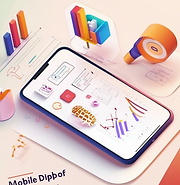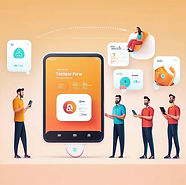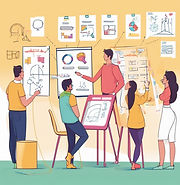
Behavioural Science for Better Digital Products
Based on behavioural science insights, BehaviourProduct.com is, above all, an invitation to think better, decide better, and build better - not just products, but cultures and outcomes that truly matter. It's designed for product enthusiasts who want to go beyond traditional methods and create meaningful, lasting impact.
This site empowers product teams to:
-
Make smarter, bias-aware decisions
-
Build better products using behavioral science
-
Drive meaningful change through thoughtful nudges

Let’s Decide Wiser with clarity,
... Design Smarter with empathy,
... and Inspire Boldly—with humility.
Decide Wiser
Design Smarter
Inspire
Boldly
Welcome, Product Enthusiast!
In the high-stakes world of digital product development, speed is expected, quality is non-negotiable, and complexity is a given. Product teams stand at the center of it all—juggling shifting priorities, managing cross-functional demands, and racing against both competitors and the next big thing.
But under pressure, even the best teams fall into invisible traps. Strategy gets sidelined. Discovery becomes a checkbox. Differentiation turns into imitation. And good intentions in design can unintentionally create friction, confusion, or choice overload.
Why? Because product decisions - like all human decisions - are vulnerable to cognitive biases. From confirmation bias to the blind spot bias, these distortions shape how we prioritize, collaborate, and build. We like to think we’re rational. But often, we act first and rationalize later. Even the most celebrated frameworks can fail if bias creeps in unnoticed.
Decide Wiser
Cognitive biases
A cognitive bias is a systematic error in thinking that affects the decisions and judgments people make.
These biases arise from mental shortcuts, emotional influences, and social pressures, often leading to irrational or flawed outcomes.
Design Smarter
Behavioural siences
Behavioral science is the interdisciplinary study of how people make decisions and behave, combining insights from psychology, economics, sociology, and neuroscience to understand and influence human actions.
Inspire
Boldly
Nudge
A nudge is a subtle change in the way choices are presented that influences behavior in a predictable way without restricting options or altering economic incentives.
Nudges are designed to help people make better decisions while preserving their freedom of choice.
I'M AN ORIGINAL CATCHPHRASE
"Subjectively, it feels like you believe in something because you have the arguments for it. But it works the other way around. You believe in the conclusion, and then you create supporting arguments. That’s fundamental."
D. Kahneman

Deciding which problems to solve by defining the product vision and objectives. This phase focuses on aligning customer needs, market opportunities, and business goals to create a clear direction for the product.

Product Development involves identifying and designing solutions that address user needs while delivering a relevant and seamless user experience.

Product
Launch
Bringing the product to market, including marketing campaigns, sales enablement, and Go-To-Market strategies.

Product Growth
Involves prioritizing roadmap developments, overseeing the product portfolio, managing end-of-life processes, and fostering product evangelization to sustain engagement and market relevance.

Way of Working
The frameworks, tools, and processes used to enhance collaboration and efficiency across all product management phases
Mapping Cognitive Biases Across Product Stages
In the journey of product management, there are five key stages where critical decisions shape a product’s success. At each of these stages, teams face recurring decision-making traps—many driven by cognitive biases.
Using a behavioral science lens, we break down these stages to reveal the most common pitfalls and the biases behind them—biases that product teams encounter every day.
But spotting them isn’t enough.
We also share simple ways to avoid these traps, along with real examples from well-known companies that show how bias can lead even top teams astray.
Explore how behavioral insights can turn blind spots into breakthroughs.
Bring Behavior Change Into Product Practice
To go further, product teams can adopt our SET BEHAviour CHANGE approach—a practical, adaptable framework designed for product leaders.
Grounded in behavioral science and inspired by the latest product design trends, it helps teams make better decisions, build more engaging and effective digital experiences, and support ethical behavior change.
SET BEHAviour CHANGE isn’t a rigid or revolutionary methodology — it’s a flexible, customizable toolkit designed to fit your team’s context, whether you're in a startup or a large organization.
Once trained, product teams can apply this approach independently. However, to ensure lasting impact, we recommend involving behavioral experts to support the responsible, meaningful, and ethical application of behavioral science.
Let’s shape better digital products — together.
Availble Supports

Cognitive Biases in Product Development
Stories of common pitfalls caused by cognitive biases in product development - and how to mitigate them (cartoons).
Implementing
SET BEHAviour CHANGE

Job role: Head of Product at “NeuroN Care” (Enterprise)
Company focus: AI-powered B2B platform for clinical diagnostics used in 45+ countries.
Enterprise

Job role: CPO of “Flowy” (Start-Up)
Company focus: A SaaS product offering mental wellness and focus tracking for remote workers.

Startup

These two examples illustrate how the approach can be applied in different types of organizations—a startup and an enterprise—highlighting how behavioral experts can be involved to support its effective implementation.
Please note that the use cases, people, and companies described here are entirely fictional.
These examples are intended solely to illustrate how the SET BEHAviour CHANGE approach can be applied in practice.



